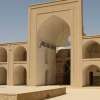History of Abarkuh Jame Mosque of Yazd
Abarkuh Jame Mosque or Two-Kiblah Mosque is located next to the Main Square, about the central part of Abarkuh. It is believed that its foundation has been established in the 1st and 2nd centuries, that is, the era in which people in Abarkuh had accepted Islam. Later it was completed and some parts have been added in Timurid era and Safavid dynasty; however, it bears its current shape form Ilkhanate Era. Generally speaking, the works of art present in this Jame Mosque belong to pre Islamic era till 13th and 14th centuries after Islam. After Safavid Era, its maintenance and reparation have been disregarded insofar as most parts of the building around the mosque have been destroyed and some buildings have been built that have nothing to do with Abarkuh Jame Mosque.
.jpg)
Architecture and Building of Jame Mosque of Abarkuh
The main part of this mosque is its four porches that surround a rectangular yard and the entrance door is directed towards the north. Here, you can inhale the Spring Wind which goes to the yard through a big octagonal corridor after entering the mosque. The mosque portal, with a high height, stands like a king and shows an octagonal scene with its three angles and three arcades. At the southern part of the entrance, there’s a shabestan with corniced arches and there’s a vast basement which upper platform is devoted for praying in the summer at the center of the mosque's platform. The porticos around the balconies are of two-floor ones. Arches are in arc and groin (element of transferring pressing loads to lateral and lower walls) shape and there’s an adjunct minaret at its southern side; while, the main shabestan is located at the southeast of the mosque. Now Abarkuh Jame Mosque has two doors; the main door which is at the northern corner of the western side and the second one or subsidiary door which is at the main street, next to the western wall of municipality building.
In addition to a couple of corridors and two shabestans behind the northern and southern porches, this mosque has a 10 ×10 cellar at the sahn (a kind of courtyard). After Mongolian era, along the big porch, a chapel has been made belonging to a series of buildings of which the most famous one is Khan Otameh Baghdad built in 755 AH. This evidence and the epigraph above the mihrab prove that these buildings belonged to the Mongolian porches.
.jpg)
Abarkuh Jame Mosque Mihrabs
Generally, Jame Mosque of Abarkuh has 5 mihrabs; the beautiful mihrab in the eastern porch with stuccowork is 4.42m wide and belongs to 738 A.H. It is one of the most exquisite mihrabs of this mosque that has been designed with different arabesque decorations and epigraphs with Naskh and Kufi script bulgy fillets. From the other 4 mihrabs in the mosque, 3 of them have been made of marble and lime and the fourth one is made of simple tile. The Main stone mihrab of Jame Mosque has 2 beautiful marble decorated pillars.
Abarkuh Jame Mosque kiblah has been built like the ones built in Mongolian era; main mihrab or the first mihrab of the mosque deviates 47 degrees from North magnetic pole, and a small mihrab with the deviation of 30 degrees modifies the previous kiblah. Abarkuh Jame Mosque has a set of rich different original architectural arts and was registered in Iran's national heritage with the registration number of 197 on July 30, 1993.
.jpg)
Abarkuh
Abarkuh is one of the important and prosperous towns of old Yazd and a pathway for the Silk Road caravans. It is named Abarkuh in Sassanid era (the era of Abarkuh’s promotion and development) due to the city positioning on the rocky hillside. Historical heritage in the city confirms that before this era, life was going on and people lived there peacefully.
.jpg)
Some of Abarkuh historical places are Gonbad Aali, Jame Mosque, Old Cypress of Abarkuh, Aghazadeh House, and Adobe Yakhchal.
To book in a tour to Abarkuh, click here.
For more information about Jame Mosque of Abarkuh, please contact Raadina Support.
Online Support











.jpg)
.jpg)
.jpg)
.jpg)
